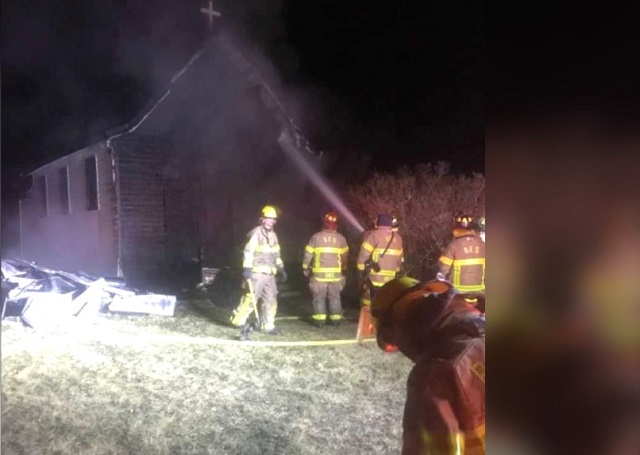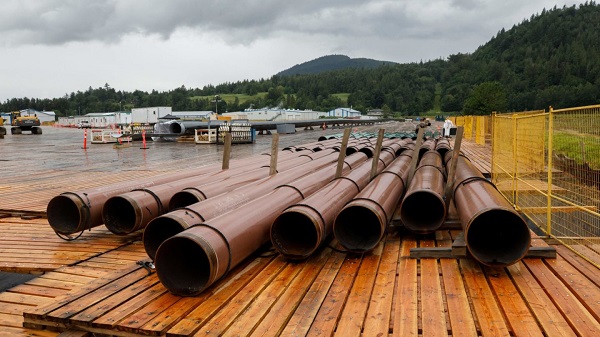Alberta
Two more historic churches in Canada set ablaze by arsonists

From LifeSiteNews
“These are absolutely despicable attacks on the Christian community”
Two historic Christian churches in Canada were intentionally set on fire late last week in what police said were suspected acts of arson.
The incident has Conservative political leaders calling for an end to “attacks” on Christianity after more than 100 churches having been targeted with arson or vandalism since 2021.
The Royal Canadian Mounted Police (RCMP) say St. Aidan’s Church, known as Glenreagh Church, and Pioneer Church, a United Church, both located in Barrhead, a town 120 miles northwest of Alberta’s capital Edmonton, were destroyed by arson within only two hours of each other on the evening of December 7.
No one was reported to have been hurt in the fires, but both churches have been extensively damaged, likely beyond repair, despite the best efforts of the Barrhead Fire Services, which was onsite quickly.
Barrhead RCMP confirmed that an initial investigation has determined that both fires were intentionally set. However, an exact motive is not yet clear.
According to eyewitnesses on the ground, two older pickup trucks were seen fleeing the scene.
An initial investigation by fire examiners confirmed that both fires were deliberately set.
Local resident Edith Strawson, whose dad helped build St. Aidan’s Church over 100 years ago, and who got married in the church, as well as some of her kids, said, “We’re putting this back together.”
“We just can’t let that happen and just leave it,” she said as per a CTV report.
Attacks on Christianity ‘must’ stop say conservative leaders
Leader of the Conservative Party of Canada (CPC) Pierre Poilievre condemned the attacks.
“These are absolutely despicable attacks on the Christian community,” Poilievre wrote Friday on X (formerly Twitter).
“Police must find and arrest the criminals responsible for setting fire to these two churches.”
These are absolutely despicable attacks on the Christian community.
Police must find and arrest the criminals responsible for setting fire to these two churches. https://t.co/ZKUHpaLrzu pic.twitter.com/c7Xxn8qMjb
— Pierre Poilievre (@PierrePoilievre) December 8, 2023
Alberta Premier Danielle Smith, the leader of the United Conservative Party, said church burnings have “no place in Alberta” and those who destroyed the churches by arson need to stand for their “crimes.”
She also confirmed that the RCMP is investigating the church fires “as suspected cases of arson.”
“Images like these have no place in Alberta,” Smith wrote Friday on X (formerly Twitter).
“To the parishioners of these churches and to the Christian community across our province, I stand in solidarity with you against all forms of hate.”
Images like these have no place in Alberta.
RCMP are investigating two churches which were destroyed by fires as suspected cases of arson.
To the parishioners of these churches and to the Christian community across our province, I stand in solidarity with you against all… pic.twitter.com/KmdQ3vc98S
— Danielle Smith (@ABDanielleSmith) December 8, 2023
Smith said that the church burnings “are condemned in the strongest possible terms and those perpetrating these crimes must be brought to justice.”
“I am closely monitoring this unfolding situation along with Minister of Public Safety and Emergency Services Mike Ellis,” she added.
Since the spring of 2021, well over 100 churches, most of them Catholic, but all Christian have either been burned or vandalized across Canada. The attacks on the churches came shortly after the unconfirmed discovery of “unmarked graves” at now-closed residential schools once run by the Church in parts of the country.
In 2021 and 2022, the mainstream media ran with inflammatory and dubious claims that hundreds of children were buried and disregarded by Catholic priests and nuns who ran some of the schools.
Despite the church burnings, the federal government under Prime Minister Justin Trudeau has done nothing substantial to bring those responsible to justice, nor to stem the root cause of the burnings.
Instead, a little over a month ago, Liberal and NDP Members of Parliament (MPs) struck down a Conservative Party of Canada motion that would have condemned incidents of church burnings and acts of vandalism.
In August of 2022, LifeSiteNews reported about the destruction by fire of one of the oldest standing Catholic churches in Alberta. Police at the time said the fire was a “suspicious” incident.
Despite the massive number of church fires in Canada, Canadian Heritage Minister Pablo Rodriguez in May made a brazen suggestion recently that the recent slew of anti-Christian church burnings in Canada could be remedied through further “online” internet regulation.
Those with any information on the church fires are asked to contact Barrhead RCMP at 403-780-674-4848.
Alberta
The case for expanding Canada’s energy exports

From the Canadian Energy Centre
For Canada, the path to a stronger economy — and stronger global influence — runs through energy.
That’s the view of David Detomasi, a professor at the Smith School of Business at Queen’s University.
Detomasi, author of Profits and Power: Navigating the Politics and Geopolitics of Oil, argues that there is a moral case for developing Canada’s energy, both for Canadians and the world.
CEC: What does being an energy superpower mean to you?
DD: It means Canada is strong enough to affect the system as a whole by its choices.
There is something really valuable about Canada’s — and Alberta’s — way of producing carbon energy that goes beyond just the monetary rewards.
CEC: You talk about the moral case for developing Canada’s energy. What do you mean?
DD: I think the default assumption in public rhetoric is that the environmental movement is the only voice speaking for the moral betterment of the world. That needs to be challenged.
That public rhetoric is that the act of cultivating a powerful, effective economic engine is somehow wrong or bad, and that efforts to create wealth are somehow morally tainted.
I think that’s dead wrong. Economic growth is morally good, and we should foster it.
Economic growth generates money, and you can’t do anything you want to do in social expenditures without that engine.
Economic growth is critical to doing all the other things we want to do as Canadians, like having a publicly funded health care system or providing transfer payments to less well-off provinces.
Over the last 10 years, many people in Canada came to equate moral leadership with getting off of oil and gas as quickly as possible. I think that is a mistake, and far too narrow.
Instead, I think moral leadership means you play that game, you play it well, and you do it in our interest, in the Canadian way.
We need a solid base of economic prosperity in this country first, and then we can help others.
CEC: Why is it important to expand Canada’s energy trade?
DD: Canada is, and has always been, a trading nation, because we’ve got a lot of geography and not that many people.
If we don’t trade what we have with the outside world, we aren’t going to be able to develop economically, because we don’t have the internal size and capacity.
Historically, most of that trade has been with the United States. Geography and history mean it will always be our primary trade partner.
But the United States clearly can be an unreliable partner. Free and open trade matters more to Canada than it does to the U.S. Indeed, a big chunk of the American people is skeptical of participating in a global trading system.
As the United States perhaps withdraws from the international trading and investment system, there’s room for Canada to reinforce it in places where we can use our resource advantages to build new, stronger relationships.
One of these is Europe, which still imports a lot of gas. We can also build positive relationships with the enormous emerging markets of China and India, both of whom want and will need enormous supplies of energy for many decades.
I would like to be able to offer partners the alternative option of buying Canadian energy so that they are less reliant on, say, Iranian or Russian energy.
Canada can also maybe eventually help the two billion people in the world currently without energy access.
CEC: What benefits could Canadians gain by becoming an energy superpower?
DD: The first and primary responsibility of our federal government is to look after Canada. At the end of the day, the goal is to improve Canada’s welfare and enhance its sovereignty.
More carbon energy development helps Canada. We have massive debt, an investment crisis and productivity problems that we’ve been talking about forever. Economic and job growth are weak.
Solving these will require profitable and productive industries. We don’t have so many economic strengths in this country that we can voluntarily ignore or constrain one of our biggest industries.
The economic benefits pay for things that make you stronger as a country.
They make you more resilient on the social welfare front and make increasing defence expenditures, which we sorely need, more affordable. It allows us to manage the debt that we’re running up, and supports deals for Canada’s Indigenous peoples.
CEC: Are there specific projects that you advocate for to make Canada an energy superpower?
DD: Canada’s energy needs egress, and getting it out to places other than the United States. That means more transport and port facilities to Canada’s coasts.
We also need domestic energy transport networks. People don’t know this, but a big chunk of Ontario’s oil supply runs through Michigan, posing a latent security risk to Ontario’s energy security.
We need to change the perception that pipelines are evil. There’s a spiderweb of them across the globe, and more are being built.
Building pipelines here, with Canadian technology and know-how, builds our competitiveness and enhances our sovereignty.
Economic growth enhances sovereignty and provides the resources to do other things. We should applaud and encourage it, and the carbon energy sector can lead the way.
Agriculture
Growing Alberta’s fresh food future

A new program funded by the Sustainable Canadian Agricultural Partnership will accelerate expansion in Alberta greenhouses and vertical farms.
Albertans want to keep their hard-earned money in the province and support producers by choosing locally grown, high-quality produce. The new three-year, $10-milllion Growing Greenhouses program aims to stimulate industry growth and provide fresh fruit and vegetables to Albertans throughout the year.
“Everything our ministry does is about ensuring Albertans have secure access to safe, high-quality food. We are continually working to build resilience and sustainability into our food production systems, increase opportunities for producers and processors, create jobs and feed Albertans. This new program will fund technologies that increase food production and improve energy efficiency.”
“Through this investment, we’re supporting Alberta’s growers and ensuring Canadians have access to fresh, locally-grown fruits and vegetables on grocery shelves year-round. This program strengthens local communities, drives innovation, and creates new opportunities for agricultural entrepreneurs, reinforcing Canada’s food system and economy.”
The Growing Greenhouses program supports the controlled environment agriculture sector with new construction or expansion improvements to existing greenhouses and vertical farms that produce food at a commercial scale. It also aligns with Alberta’s Buy Local initiative launched this year as consumers will be able to purchase more local produce all year-round.
The program was created in alignment with the needs identified by the greenhouse sector, with a goal to reduce seasonal import reliance entering fall, which increases fruit and vegetable prices.
“This program is a game-changer for Alberta’s greenhouse sector. By investing in expansion and innovation, we can grow more fresh produce year-round, reduce reliance on imports, and strengthen food security for Albertans. Our growers are ready to meet the demand with sustainable, locally grown vegetables and fruits, and this support ensures we can do so while creating new jobs and opportunities in communities across the province. We are very grateful to the Governments of Canada and Alberta for this investment in our sector and for working collaboratively with us.”
Sustainable Canadian Agricultural Partnership (Sustainable CAP)
Sustainable CAP is a five-year, $3.5-billion investment by federal, provincial and territorial governments to strengthen competitiveness, innovation and resiliency in Canada’s agriculture, agri-food and agri-based products sector. This includes $1 billion in federal programs and activities and $2.5 billion that is cost-shared 60 per cent federally and 40 per cent provincially/territorially for programs that are designed and delivered by provinces and territories.
Quick facts
- Alberta’s greenhouse sector ranks fourth in Canada:
- 195 greenhouses produce $145 million in produce and 60 per cent of them operate year-round.
- Greenhouse food production is growing by 6.2 per cent annually.
- Alberta imports $349 million in fresh produce annually.
- The program supports sector growth by investing in renewable and efficient energy systems, advanced lighting systems, energy-saving construction, and automation and robotics systems.
Related information
-

 Health2 days ago
Health2 days agoUS podcaster Glenn Beck extends a lifeline to a Saskatchewan woman waiting for MAiD
-

 Automotive1 day ago
Automotive1 day agoThe $50 Billion Question: EVs Never Delivered What Ottawa Promised
-

 Local Business1 day ago
Local Business1 day agoRed Deer Downtown Business Association to Wind Down Operations
-

 C2C Journal1 day ago
C2C Journal1 day agoWisdom of Our Elders: The Contempt for Memory in Canadian Indigenous Policy
-

 International24 hours ago
International24 hours agoTrump admin wants to help Canadian woman rethink euthanasia, Glenn Beck says
-

 Censorship Industrial Complex2 days ago
Censorship Industrial Complex2 days agoLiberals gain support for ‘hate speech’ bill targeting Bible passages against homosexuality
-

 Censorship Industrial Complex1 day ago
Censorship Industrial Complex1 day agoConservative MP calls on religious leaders to oppose Liberal plan to criminalize quoting Scripture
-

 Alberta1 day ago
Alberta1 day agoAlberta introducing three “all-season resort areas” to provide more summer activities in Alberta’s mountain parks







